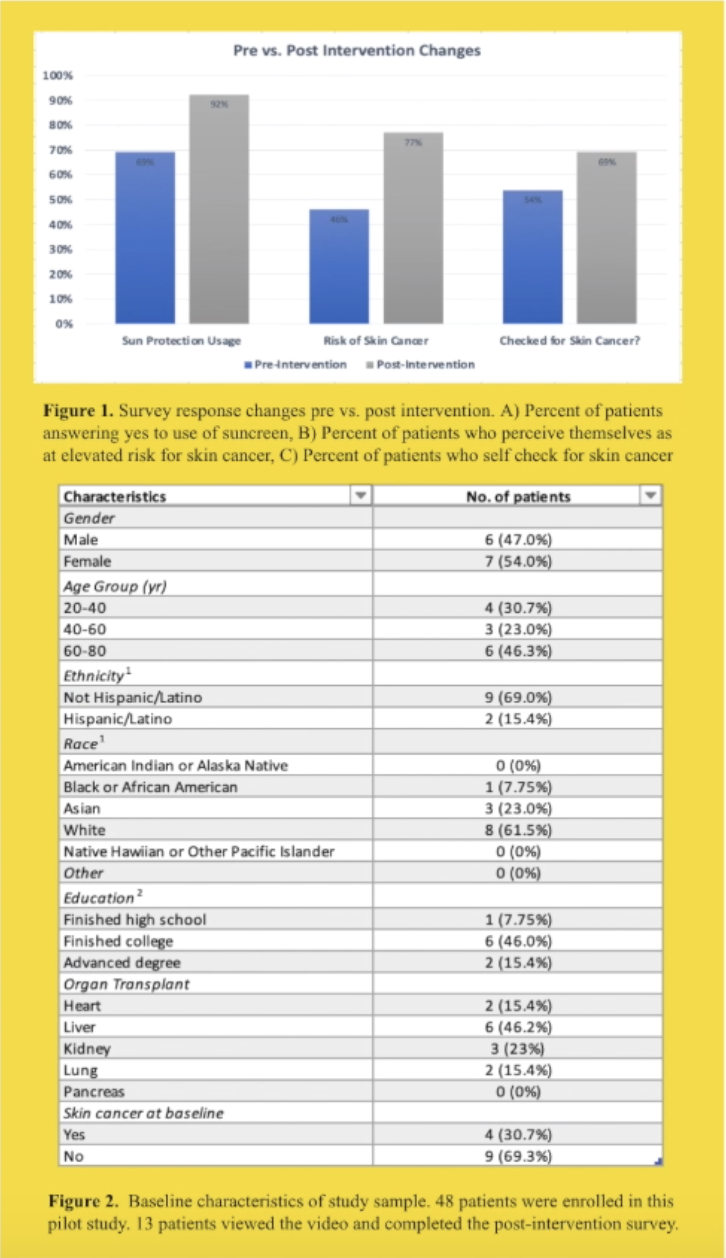Seeing is Believing: Efficacy of a Video-based Intervention in Improving Awareness of Skin Cancer Risk for Solid Organ Transplant Recipients
1Keck School of Medicine, Los Angeles, CA, 2Dermatology, Keck School of Medicine, Los Angeles, CA
Meeting: 2021 American Transplant Congress
Abstract number: 1280
Keywords: Hispanic, Patient education, Post-transplant malignancy, Public policy
Topic: Clinical Science » Organ Inclusive » Non-Organ Specific: Disparities to Outcome and Access to Healthcare
Session Information
Session Name: Non-Organ Specific: Disparities to Outcome and Access to Healthcare
Session Type: Poster Abstract
Session Date & Time: None. Available on demand.
Location: Virtual
*Purpose: Our research focuses on the efficacy of using a novel video-based intervention to educate solid organ transplant recipients on their increased risk of skin cancer. I will be referring to solid organ transplant recipients as SOTR in this abstract.
*Methods: In this ongoing prospective study, SOTR from our majority-Hispanic patient population at Los Angeles County Hospital and Keck Hospital of USC seen by our dermatology department were enrolled. Participants completed a pre-intervention survey measuring their perceived risk of developing skin cancer and their sun protective behaviors. We developed an informational video in English and Spanish highlighting the increased risk posed to transplant recipients in developing non-melanoma skin cancer and preventive strategies, including sunscreen, protective clothing, self-skin checks, and dermatology follow ups. After viewing the video, patients were completed a post-intervention survey to see if their perceptions and practices regarding skin cancer had changed.
*Results: A total of 48 SOTR patients were enrolled in the study. We analyzed the results 13 patients who completed both in the pre- and post- intervention survey. As shown in Figure 1, 69% of patients reported sunscreen use pre-intervention compared to 92% of patients post-intervention. In addition, 46% of patients reported an improved understanding of their skin cancer risk pre-intervention compared to 77% of patients post-intervention and 54% of patients had checked for skin cancer in the past month pre-intervention compared to 69% of patients post-intervention. Of the 48 enrolled participants, 58.8% identified as Hispanic or Latino, however of the 13 who completed the post-intervention surveys only 15.4% identified as Hispanic or Latino. We are currently enrolling more patients in hopes of achieving a more representative demographic breakdown.
*Conclusions: Our study builds on prior literature which demonstrates the efficacy of video-based messaging and intervention on behavior change to reduce the risk of skin cancer in the general population as well as in SOTR. This intervention presents a cost-effective and timely method to increase awareness of skin cancer for at-risk patients. In addition, the discrepancy of Hispanic and Latino patient enrollment pre and post intervention highlights the need to address how to improve study retention of minority patients.
To cite this abstract in AMA style:
Shah E, Michalak S, Haughton R, Fernandez B, Ahronowitz I. Seeing is Believing: Efficacy of a Video-based Intervention in Improving Awareness of Skin Cancer Risk for Solid Organ Transplant Recipients [abstract]. Am J Transplant. 2021; 21 (suppl 3). https://atcmeetingabstracts.com/abstract/seeing-is-believing-efficacy-of-a-video-based-intervention-in-improving-awareness-of-skin-cancer-risk-for-solid-organ-transplant-recipients/. Accessed December 28, 2025.« Back to 2021 American Transplant Congress

